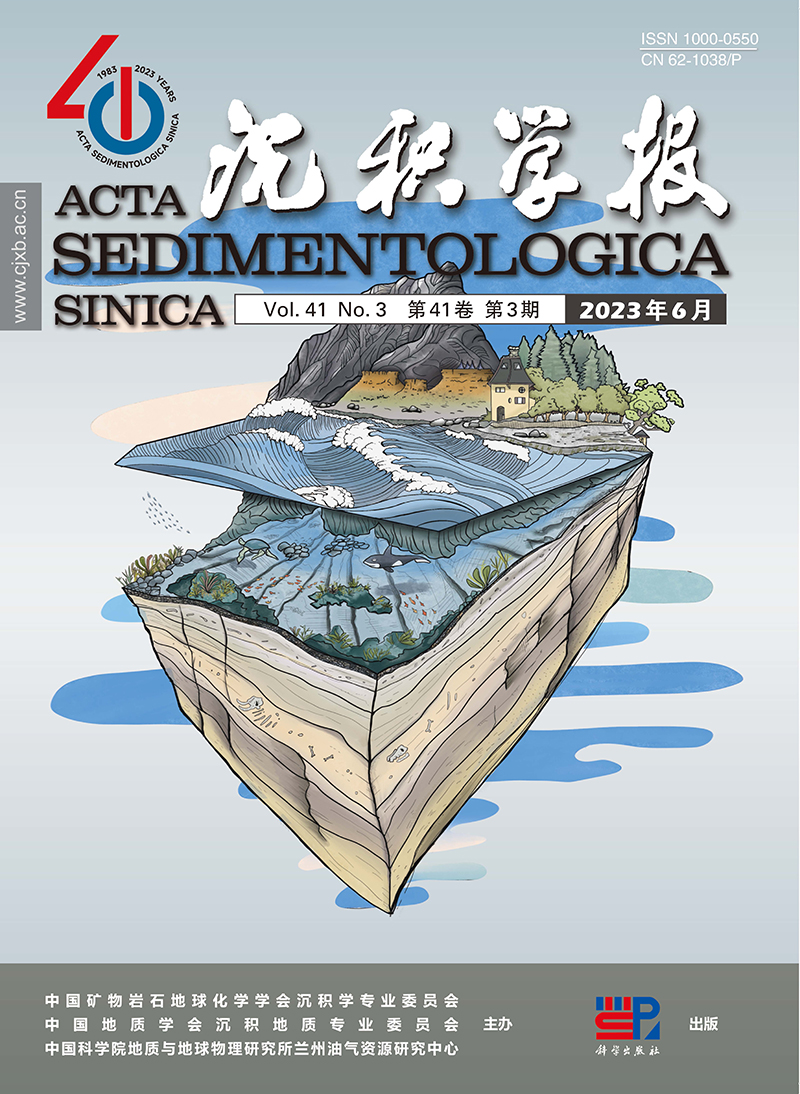HTML
-
长期以来,随着对北方黄土广泛并系统的研究,其形成机理例如物质来源、搬运风力及黄土区形成环境等已经取得较为清晰的认识[1⁃2],但同样分布广泛的南方红土在是否可用于重建古气候及网纹成因等方面还存在较大的争议[3⁃7]。有研究者认为[4,8⁃9],与黄土类似,第四纪红土存在的多个“沉积—成土”旋回可以反映“冷干—暖湿”的气候变化,但也有学者[5,10]提出,黄土—古土壤序列中可作为代用气候指标的磁化率无法适用于南方第四纪红色黏土沉积层内。网纹成因也有砾石风化作用[11]、植物根系作用[4]、地下水作用[12]和微环境差异作用[13]等多种观点。气候载体与成因涉及网纹红土发生的气候环境背景和形成机理,深入研究对于更好认识南方古地理环境具有重要意义。常见南方红土剖面结构自上而下多为黄棕色土层、均质红土层、网纹层和砂砾石层,其中网纹红土层具有特殊的红、白网纹交织现象,引起众多学者的关注,并对其展开了年代、色度、粒度、环境磁学、矿物学、地球化学、土壤微形态学、分子化石和数学模型等研究[2,6⁃7,14⁃25]。土体网纹的形成及醒目的红、白色调与铁的迁移及含有不同致色性氧化铁矿物密不可分,土壤颜色和氧化铁矿物具有较好的相关性[10,26]。
环境磁学其在北方黄土研究中有广泛的应用,研究表明磁化率可以反映东亚夏季风强度,较好地反演古气候[27⁃30]。红土作为南方常见的第四纪土状堆积[31],学者们利用磁学方法对红土层中所含磁性矿物的类型、磁学特性和对气候的反演等进行了研究。宣城[30]、杭州[32]、泰和、九江、宣州[33]、长沙、岳阳、南昌、新余和金华[34]等多地的磁化率和频率磁化率表现出随剖面深度增加而降低的趋势,黄棕色土和均质红土的磁性矿物含量远高于网纹红土[35]。通过红土的磁学研究,有研究者[30,35⁃37]提出,红土磁化率可以反映成土强度,指示降水和古气候变化。但也有研究者[5,14,33,38⁃39]认为,网纹红土的低磁化率是由于铁迁移导致的,成土作用中的风化强度并非磁化率的控制因子,土壤中原生磁铁矿的残留量或转化程度决定了磁化率值的大小,无法反映其成土强度,因此不能明确地指示古气候变化。以往磁学研究主要利用全样进行分析,但构成网纹红土全样的红网纹和白网纹在形态、地球化学性质等方面均存在较大差异[19,23,40],易忽略红网纹和白网纹不同理化性质带来的差别影响。通过环境磁学方法可以较好地辨别红、白网纹中的磁性矿物类型、含量和粒度等,进而推演古环境。因此,分离红网纹和白网纹并研究其磁学特性显得尤为必要。本文将通过多种磁学参数并辅助地球化学指标,探讨南方红土各层及网纹层内红网纹和白网纹磁学特征差异及发生原因,解析网纹红土发育过程中磁性矿物形成响应模式,阐明磁性矿物的类型、数量、磁畴等对网纹红土磁学参数的贡献。
-
实验样品采集于浙江金华汤溪镇的丘陵岗地(图1),地理坐标为29°1′55″ N,119°25'27" E。该区域位于金衢盆地,为典型的亚热带季风气候,季节间的干湿差异明显,雨热条件好,年均温16.3 ℃~17.6 ℃,年降水1 300~2 200 mm。剖面出露厚度约3.7 m,由上而下分为3层:1)表土层(0~40 cm),呈棕红色,土质较为松散,有植物根系发育,与下伏黄棕色土层呈渐变过渡。2)黄棕色土层(40~50 cm),为表土层和网纹层之间的过渡层,呈暗黄棕色,较为疏松,下部发育铁锰胶膜和结核。3)网纹红土层(50~370 cm),相较上层,土质更加紧实,可见铁锰胶膜,白色网纹,形态呈条带状和圆点状,条带状网纹走向有横向和纵向,网纹层下部,网纹粗大且界限明显。
-
在表土层(35 cm)采集样品1块,黄棕色土层采集样品2块,采样深度分别为45 cm和50 cm,网纹红土层则根据沉积特点进行分段采样,深度50~210 cm间隔10 cm、210~370 cm间隔20 cm采样,共采集样品25块。样品置于40℃恒温烘箱烘干后,按红网纹和白网纹两类对其进行分离,共计获得44块红、白土样。分别将表土层、黄棕色土层、胶膜层及网纹红土的红网纹和白网纹样品研磨均匀,称重5 g,装入2 cm×2 cm×2 cm的小盒中进行磁学参数测量;并将上述各样品研磨压片,用PHLIPS公司生产的PW2440型X射线荧光光谱仪进行主量元素测量,分析误差小于2%。
使用Bartington MS2双频磁化率仪在0.1档测试低频(0.47 kHz,χlf)和高频(4.7 kHz,χhf)磁化率,并计算频率磁化率χfd=χlf-χhf及其百分数χfd%=(χlf-χhf)/χlf×100。其他参数:非磁滞剩磁(ARM)是利用D2000交变退磁仪(交变磁场峰值100 mT,直流磁场0.01 mT)测得,本文用磁化率形式χARM表示。等温剩磁(IRM)是使用MMPM10脉冲磁化仪和Minispin旋转磁力仪测定。并计算饱和等温剩磁(SIRM)、硬剩磁(HIRM=SIRM+IRM-300 mT)、退磁参数S-100(0.5(SIRM-IRM-100 mT)/SIRM)和S-300(S-300=0.5(SIRM-IRM-300 mT)/SIRM)以及比值参数SIRM/χ、χARM/SIRM、SIRM100 mT/SIRM。热磁曲线使用卡帕乔MFK1-FA磁化率仪测量,最高温度为700 ℃。整个前处理和磁学、地球化学实验均在浙江师范大学地理过程实验室完成。
1.1. 研究区概况
1.2. 样品采集与测试
-
如表1所示,表土层主量元素难溶组分(SiO2、Al2O3、Fe2O3)三者质量分数之和为92.11%,易溶组分(K2O、CaO、Na2O、MgO)质量分数之和为3.17%;化学蚀变指数(CIA)、硅铝铁率(SiO2/R2O3)和淋溶指数(ba)分别为83.50%、0.19和0.34。网纹红土全样的难溶组分质量分数之和均值达到91.44%,易溶组分质量分数之和均值3.06%;CIA、SiO2/R2O3和ba的均值分别为85.27%、5.07和0.29。红、白网纹难溶组分质量分数之和均值分别为89.62%、94.96%;易溶组分质量分数之和均值分别为2.85%、3.37%;CIA分别为85.50%和84.26%,ba分别为0.27和0.31。不论是表土还是网纹红土,MnO和P2O5含量均值均低于0.1%。由表土层和网纹层的主量元素特征对比及相关的风化指数可知,网纹层风化淋溶更加强烈,且网纹层内红网纹的风化强于白网纹。在各主量元素组成中,Fe2O3差异最为明显:网纹层全样(7.43%)高于表土层(6.11%),红网纹(9.53%)含量是白网纹(3.21%)近乎3倍。R2O3则是白网纹(6.16%)较红网纹(4.59%)偏高。
样品(数量) SiO2 Fe2O3 Al2O3 K2O Na2O CaO MgO TiO2 MnO P2O5 CIA SiO2/R2O3 ba 表层土(n=1) 70.07 6.11 15.93 1.15 1.08 0.07 0.87 1.18 0.06 0.07 83.50 0.19 0.34 全样(n=22) 平均值 66.27 7.43 17.74 1.17 1.04 0.08 0.77 1.15 0.03 0.06 85.27 5.07 0.29 最小值 61.17 5.75 15.05 1.01 0.97 0.06 0.37 0.56 0.02 0.05 83.53 3.80 0.21 最大值 71.39 10.21 22.79 1.54 1.07 0.17 0.76 1.33 0.05 0.09 87.87 6.40 0.34 红网纹(n=22) 平均值 62.62 9.53 17.47 1.12 0.96 0.08 0.69 1.11 0.03 0.07 85.50 4.59 0.27 最小值 53.17 6.92 15.07 0.93 0.83 0.06 0.42 0.46 0.03 0.06 82.80 3.22 0.18 最大值 69.73 15.18 21.03 1.25 1.04 0.18 0.80 1.29 0.04 0.09 88.76 6.07 0.33 白网纹(n=22) 平均值 73.31 3.21 18.44 1.24 1.14 0.09 0.90 1.25 0.02 0.04 84.26 6.16 0.31 最小值 64.43 2.74 14.79 1.09 1.16 0.07 0.81 0.81 0.02 0.04 82.19 4.10 0.23 最大值 76.90 4.10 24.98 1.45 0.15 0.17 1.02 1.36 0.04 0.06 87.78 7.49 0.36 注: CIA、ba、SiO2/R2O3均按分子比计算,CIA=Al2O3/(Al2O3+CaO+Na2O+K2O)×100,其中CaO指硅酸盐矿物中的摩尔含量,本文采用Mclennan的方法[41]矫正其含量;ba=(K2O+CaO+Na2O+MgO)/Al2O3;R2O3=(Al2O3+Fe2O3)。 -
磁化率(χ)可以代表土壤中反铁磁性、顺磁性和各种铁磁性矿物的感应磁化强度的贡献[42]。在正向加1 000 mT直流得到饱和等温剩磁(SIRM),可指示总磁性矿物含量的多少。当晶粒尺寸大于超顺磁(SP)/单畴(SD)阈值时可用作总磁性矿物浓度的近似值,和χ相比其不受超顺磁颗粒矿物和反铁磁性矿物的影响[43]。金华剖面的表土层磁化率85.20×10-8 m3·kg-1,明显大于红、白网纹均值(15.18×10-8 m3·kg-1、6.12×10-8 m3·kg-1)。就网纹层而言,剖面由上至下红网纹χ先降低后增大,SIRM逐渐增大;白网纹的χ和SIRM低于红网纹,垂向变化不明显(图2a,b)。从上述红、白网纹磁学特征可推断,红网纹铁磁性矿物含量多于白网纹,且这种差异随着深度增加而增大。
硬剩磁(HIRM)多用于指代弱磁性、高矫顽力的如赤铁矿和针铁矿等反铁磁性矿物含量,可以定量说明混合矿物中反铁磁性矿物的绝对浓度[44]。金华剖面表土层HIRM值较小5.75×10-5 Am2/kg,黄棕色土层为44.10×10-5 Am2/kg(图2c)。白网纹HIRM均值(6.99×10-5 Am2/kg)很小,自上而下几乎无波动;红网纹HIRM均值(88.38×10-5 Am2/kg)则很大,且随着深度增加而增大(图2c)。到网纹层下部,红网纹与白网纹的HIRM差值进一步拉大。上述各层的HIRM值差异表明:表土层、黄棕色土层及白网纹反铁磁性矿物含量较少,而红网纹的反铁磁性矿物绝对含量有随深度下降而增多的趋势。
S-ratio(S-100、S-300)提供了高矫顽力剩磁和低矫顽力剩磁相对含量的度量,其值随着不完整反铁磁性矿物含量的增加而下降,值越接近0,表明不完整反铁磁性矿物浓度越大;越接近1,则亚铁磁性矿物含量越高[45]。因此,S-ratio可反映混合矿物中反铁磁性矿物的相对浓度。金华剖面中S-ratio值表现出与HIRM值相反的趋势,表土层和黄棕色土层为剖面最大值,白网纹值大于红网纹(图2g)。垂向上,红网纹S-ratio值自上而下呈降低趋势,在260 cm以下有所回升,而白网纹未有明显变化(图2g)。这表明表土层、黄棕色土层和白网纹的亚铁磁性矿物相对含量较高,而红网纹的反铁磁性矿物(赤铁矿、针铁矿等)相对含量较高,且随着深度增加而增高,与HIRM值反映的结果一致。另一方面,从红网纹S-ratio值自260~370 cm增大推测,该段红网纹中亚铁磁性矿物相对含量也有所增加。
SIRM100 mT/SIRM常被应用于指示赤铁矿含量的相对含量变化,值越大相对含量越多[46]。在金华剖面中,表层土、黄棕色土和白网纹的SIRM100 mT/SIRM值均较低,而红网纹的参数曲线自上而下呈明显增加趋势(图2h),指示前面三者赤铁矿的相对含量较少,红网纹中赤铁矿相对含量则随着深度增加而增多,与前面几个参数所反映的结果一致。
等温剩磁(IRM)和反方向磁场退磁可以提供有关矫顽力(Bc)和剩磁矫顽力(Bcr)分布的信息,有助于区分具有不同矫顽力和剩磁矫顽力磁性矿物[46⁃47]。
IRM在常温下可以用于区分样品中“软”、“硬”磁组分。随着外加磁场强度的增加,磁铁矿和磁赤铁矿等“软”磁组分矿物容易饱和,甚至在较低场(300 mT)范围内就能达到饱和;反之,赤铁矿、针铁矿等“硬”磁组分矿物在1 T或者更高磁场下都难达到饱和[35]。本文选取深度为35 cm的表层土和85 cm的网纹红土,测得最大强度为1 T的连续可变强磁场下表层土和白、红网纹样品等温剩磁获得曲线。如图3所示,表层土的IRM在100 mT之前磁化强度上升迅速,且其SIRM获得曲线在外场0.3 T之前达到90%以上,处于基本饱和状态,说明磁赤铁矿和磁铁矿等低矫顽力的软磁性矿物为表层土的主要剩磁携带者。红网纹和白网纹的IRM曲线则有所不同,在0.3 T之前两者曲线上升速度都低于表层土,但红网纹这种差异更为明显。相较而言,白网纹上升速度更快,红网纹较慢。这一现象证明,白网纹含有一定的软磁性矿物,而红网纹则多为高矫顽力的硬磁性矿物。该结论也得到了剩磁矫顽力数据的支持。
剩磁矫顽力(Bcr)是使获得SIRM的样品剩磁降低到0所需的反向磁场,可用于了解样品“软”“硬”剩磁组分含量和粒度等信息[35]。如图3所示,表层土和白网纹的剩磁矫顽力较低(0~100 mT),红网纹的剩磁矫顽力明显大于白网纹和表层土,超过400 mT。说明红网纹磁性组分主要为赤铁矿、针铁矿等高矫顽力的硬磁性矿物,而表层土则为低矫顽力的软磁性矿物(如磁赤铁矿、磁铁矿等),且相较于红网纹,白网纹含有一定的低矫顽力磁性矿物。IRM获得曲线表明表土层和白网纹剩磁特征受亚铁磁性矿物主导,而红网纹则主要为反铁磁性矿物所主导。
热磁分析(χ-T)可以提供铁磁性矿物居里温度,从而判断磁性矿物种类和粒度分布[48],如580 ℃为磁铁矿居里温度,680 ℃为赤铁矿居里温度[12]。本文选取表土层、黄棕色土层和网纹层的白、红网纹样品各一个。表层土的χ-T曲线(图4)从常温到300 ℃缓慢上升,并在300 ℃附近出现峰,从300 ℃~450 ℃,曲线明显下滑,之后曲线继续上升,500 ℃左右再次出现隆起,随后在520 ℃~580 ℃迅速降低。前人研究揭示,300 ℃~450 ℃磁化率显著下降可能是磁赤铁矿受热向赤铁矿转化的结果[49]。而300 ℃附近的凸起可能由于土样中SD磁性颗粒解阻[50]或低磁化率矿物受热转化为磁赤铁矿等强磁性矿物[51]。500 ℃附近出现的峰值可能为样品受热含铁硅酸盐矿物或黏土矿物分解形成磁铁矿[21]。冷却曲线在400 ℃附近的隆起可能是加热时新的强磁化率矿物的生成[35]。金华剖面表土层样品热磁曲线580 ℃为磁铁矿的居里温度,指示磁铁矿可能为该层的主要磁性矿物,冷却曲线的χ在585 ℃快速上升也可证明磁铁矿的主导作用。黄棕色土的加热曲线在300 ℃左右也出现峰,并在300 ℃~400 ℃明显下滑,之后继续上升,510 ℃左右再次出现隆起,随后在580 ℃附近迅速降低,且冷却曲线χ值显著大于加热曲线,可能土样在受热中有磁铁矿的生成。通过比较不难发现,黄棕色土和表层土的χ-T曲线特征极为相似,表明两者的磁性矿物均主要为磁铁矿和成土成因的细颗粒磁赤铁矿。
在网纹红土中,白网纹的加热曲线(图4)在250 ℃~300 ℃有所上升,可能是新生成了少量亚铁磁性矿物;而300 ℃后出现的下降则是细粒磁赤铁矿转变成了赤铁矿。此外分别在300 ℃和510 ℃左右出现的峰值与表层土的成因类似。从室温到520 ℃加热曲线较为平坦,只有微弱起伏和部分峰,在520 ℃~580 ℃忽然下降,说明其居里温度为580 ℃,指示其含有一些较粗的磁铁矿。白网纹在冷却到室温时,磁化率显著增大,但红网纹的磁化率在加热前后差别不明显,表明白网纹在加热过程中有新的磁性矿物形成,后者则很少。
金华剖面红网纹的χ-T曲线在300 ℃前的缓慢降低可能由细粒磁赤铁矿造成,而280 cm处样品χ于600 ℃附近快速下降,也显示了磁赤铁矿的存在;680 ℃后磁化率才接近0,为赤铁矿的居里点,指示存在赤铁矿。结合IRM获得曲线,红网纹样品的χ-T曲线显示了钛磁铁矿及细粒赤铁矿在不同温度区间的解阻,证明红网纹可能含有更多的细粒赤铁矿。75 cm处冷却曲线与加热曲线相比,峰值更高且温度更低,表明有细粒磁铁矿的生成。此外,部分加热曲线磁化率存在很多峰值,可能由少量的纤铁矿、针铁矿受热脱水转化成其他磁性矿物(如赤铁矿或磁赤铁矿等)或含铁硅酸盐矿物转化生成磁铁矿所致。
综上,该剖面不同土壤的磁性矿物类型存在差异,表土层和黄棕色土层主要为磁铁矿和磁赤铁矿,亚铁磁性矿物多于网纹层;网纹层的红网纹有亚铁磁性矿物和反铁磁性矿物,以反铁磁性矿物赤铁矿为主,含量随着深度下降而增加;白网纹的磁性矿物中存在一定的磁赤铁矿和磁铁矿,但含量较低,且剖面中磁性矿物含量变化不大。
-
磁性矿物的粒度对环境很敏感,在风化成土过程中产生较多的细磁性矿物颗粒,被广泛应用于环境研究[34,52]。百分比频率磁化率(χfd%)是SP颗粒对样品质量归一化磁化率(χ)贡献的度量,可以反映成土样品中SP颗粒的含量[53]。当土壤的χfd%小于2%时,则样品几乎不含SP颗粒,含量在10%以下;χfd%为2%~10%时,则MD、SD、SP颗粒同时存在;χfd%为10%~14%时,则主要为SP颗粒,含量超过75%[54]。金华剖面表土层和胶膜层χfd%分别为15.73%和13.41%,黄棕色土层3.89%(图2f)。从上述数据不难推断,表土层和胶膜层存在大量SP颗粒,黄棕色土层MD、SD、SP颗粒同时存在。在网纹层,红网纹的χfd%(1.53%~15.89%)自上而下有降低的趋势,指示随着深度下降SP颗粒含量减少,上层存在SP颗粒,而下层部分样品含有较少甚至不含SP颗粒。
SIRM/χ可用于检测磁晶粒尺寸的变化,较低值可归因于SP等小颗粒浓度较高[45]。ARM主要由单畴(SD)和假单畴(PSD)亚铁磁性颗粒所贡献,因此χARM可以用于估计SD和PSD颗粒含量[55]。χARM/SIRM随着铁磁性颗粒的增大而减小,该参数可避免由于SP颗粒带来的不确定性,较低的比值反映存在较粗的PSD+MD(假单畴与多畴)组分[56]。金华剖面网纹红土下层红网纹的SIRM/χ值(图2d)明显升高,指示土体中SP浓度显著降低,磁性颗粒变粗。从ARM分析,金华剖面红网纹的χARM/SIRM值(图2e)在网纹层中随着深度降低而减小,反映了网纹红土上层的红网纹铁磁性颗粒较细,下层则为较粗的PSD+MD(假单畴与多畴)颗粒,与χfd%、SIRM/χ指示结果一致。
结合χfd%和χARM/SIRM散点图(图5)推断,表土层以SP颗粒为主,黄棕色土层则是MD、SD、SP颗粒同时存在。网纹红土上、下层的红网纹中磁性矿物粒度存在差异:上层,存在部分SP颗粒;下层,红网纹中的磁性颗粒则以MD、PSD和SSD为主。而白网纹在图中散布凌乱,不具指示意义。
综上,表层土以SP等细磁性颗粒为主,黄棕色土则SP、PSD+MD等粗、细磁性颗粒并存。而红网纹上层主要为SP细磁性颗粒,下层则MD、PSD等粗颗粒为主。白网纹由于磁性过弱,磁畴指标参数值多为误差,无法较好地反映其磁性颗粒大小,故不展开叙述。
2.1. 主量元素组成
2.2. 磁性矿物类型
2.3. 磁性矿物粒度
-
网纹形成及红、白色调的分异和铁形态及迁移密不可分,不同类型的氧化铁矿物使网纹红土层具有差异性的颜色和磁学性质[39]。同时,土体中铁的含量(全铁)也可较为直观地反映土壤中铁富集或缺失,进而影响土壤颜色[57]。氧化铁形态和氧化铁风化指标常被用于表征氧化铁特性,也因对地理环境变化的强敏感性多用于土壤学研究[58]。借鉴前人方法[25,59],本文也选择金华剖面表层土壤全铁含量(6.11%)作为背景,通过对比发现,白网纹全铁含量(3.21%)明显低于表土层,指示存在铁流失;红网纹(9.53%)则铁相对富集(表1),这和李凤全等[25]关于白色条纹中的铁存在网纹层内迁移的结论相符合。
袁双[57]对金华汤溪网纹红土的红、白网纹铁形态做了详尽的研究,发现红网纹游离氧化铁含量达80 g/kg,显著高于白网纹(18 g/kg);红网纹的铁游离度(Fed/Fet)为80%,也明显大于白网纹(55%)。宣城[12]、九江[60]等地红、白网纹表现出同样的特性。活化度(Feo/Fed)方面,白网纹(0.14%)高于红网纹(0.11%)。红网纹晶质氧化铁含量(70.88 g/kg)显著大于白网纹(15.50 g/kg)。本文剖面样品虽未做铁形态实验,但因与袁双[57]的研究剖面同属汤溪地区,相距较近,结构相同,且其对金衢盆地多个地点样品分析发现,红、白网纹的铁形态都具有较好的相似性。因此,下述分析也建立在袁双[57]研究的基础上。游离氧化铁(Fed)是母岩成土过程中风化后形成的次生氧化物,与游离度(Fed/Fet)可较好地反映土壤的风化强度[39,60]。红网纹的高Fed含量和高Fed/Fet表明其经历了较强风化作用,虽然白网纹较高CIA值(图2i)说明其也经历了较强风化,但Fed和Fed/Fet值却相对较低,结合白网纹相对更高络合铁含量指示其更富迁移性。因此,白网纹全铁的较低值证明了铁质迁出的影响。活化度(Feo/Fed)可以衡量土壤中铁矿物结晶的相对优劣度[61],低活化度偏向形成较好结晶度铁氧化物[39]。红网纹活化度低于白网纹表明前者氧化铁结晶度要强于后者,指示前者可能多含结晶度较好的铁氧化物。针铁矿和赤铁矿是常见的晶质氧化铁,而赤铁矿更是大量存在于高度风化的南方红土中的强致色矿物[39]。借鉴前人的研究结果推论,金华剖面红网纹晶质氧化铁含量显著大于白网纹,而且红网纹含有较多的赤铁矿。从红、白网纹的全铁及铁形态可知,赤铁矿等晶质氧化铁主要存在于红网纹中,而白网纹则明显缺失,这正是导致两者颜色和磁学性质有所不同的原因。
-
在温带半干旱的黄土研究区,土壤磁化率和其成壤强度呈正相关,但磁化率在降水量超过某个临界值(1 200 mm)反而会下降[28,62]。网纹红土处于高温高湿的地理环境,经历了强淋溶、强风化作用,作为成壤作用最强的层位磁化率往往最低[35,63⁃64]。金华剖面中表土层具有较高的SP颗粒含量,磁性矿物颗粒较细,类型以磁铁矿和磁赤铁矿为主,磁化率高于网纹红土层,且为剖面最大值。在风化成土过程中,母质中的铁通过释放形成次生的含铁矿物,例如各类磁性矿物,再经溶解、转化和迁移沉淀等过程使这些矿物在类型、含量和粒径大小等方面发生改变[65]。南方红土经历了较强的化学风化,一定的成壤作用使土壤的磁性颗粒变细[66],这也是金华剖面表土层磁性颗粒较细小的原因。另一方面,成土作用会使亚铁磁性矿物转化为微晶强磁性的磁铁矿和磁赤铁矿,特别是成土过程中形成的SP和SD磁赤铁矿会导致土壤沉积物磁性矿物增强。与下层强风化的网纹红土(CIA为85.27%)相比,表土层(CIA为83.50%)属中度化学风化(图2i),脱硅富铝铁化使得铁磁性矿物相对富集,因风化成土作用相对较弱,来自原始母质的磁铁矿、磁赤铁矿等亚铁磁性矿物得以保留。此外,有机质对土壤中次生亚铁磁性矿物的生成具有促进作用[67],还会使磁赤铁矿不易氧化,阻碍其进一步转变成赤铁矿[68]。在野外调查中发现,该层存在较多的植物根系和土壤动物活动痕迹。由此可见,成壤作用、中等强度的风化以及生物的作用导致了金华剖面表土层的高磁化率。
-
与前人研究类似[35,63],金华剖面不论是红网纹还是白网纹,磁化率都显著低于表土层(图2a)。表层土的Fe2O3(6.11%)含量小于网纹全样(7.29%)(表1),但磁化率远大于后者,说明两者的磁性矿物种类、含量及磁畴大小等方面可能存在差异。从前文分析可知,金华剖面的网纹红土层以反铁磁性矿物占主导,亚铁磁性矿物含量低。与上覆底层相比,网纹红土具有较高风化强度(表1)。前人在其他网纹红土剖面也发现Fed和Fed/Fet随深度下降而增加[12,39,69⁃70],反映网纹红土风化成土作用愈往下愈强。强风化成土作用使磁赤铁矿向赤铁矿转化造成网纹层磁性显著减弱[71]。此外,高温高湿的土体环境会使土壤矿物发生溶解,赤铁矿、针铁矿等反铁磁性矿物的抗溶解性较强于磁铁矿、磁赤铁矿等亚铁磁性矿物[12,65]。在网纹红土成土期,南方降水充沛,夏季风强盛[16],亚铁磁性矿物在外部强降水、内部活跃地下水共同作用下发生溶解,未溶解的磁赤铁矿等受强风化作用向赤铁矿转化,从而造成亚铁磁性矿物大量缺失,而赤铁矿等反铁磁性矿物成为网纹层的主要磁性矿物,使得网纹层的χ降低。此外,金华剖面网纹层随深度下降受地下水作用增强且风化强度变大,导致赤铁矿含量有向下增多的趋势。
-
白网纹的χ等磁性微弱且剖面上没有明显的波动,而红网纹磁化率等高于白网纹且垂直变化特征明显。究其原因,白网纹存在铁的流失,红网纹则是富集。剖面下部,红网纹中铁的富集程度明显高于上部(图2j)。红、白网纹两者铁形态也差别明显:红网纹的晶质氧化铁含量远高于白网纹,而后者络合铁却略高于前者。等温剩磁曲线和热磁曲线(图3,4)均显示白网纹含有亚铁磁性矿物,但χ、SIRM、HIRM等值(图2a~c)很低,说明其磁性矿物总量很少。白网纹内较低晶质氧化铁和较高络合铁含量不利于铁氧化物的结晶但有利于铁质的迁移,低游离铁和全铁含量也从地球化学角度指示了白网纹中铁质的大量流失。此外,在雨季较轻的Fe同位素会优先以Fe2+形式还原溶解到溶液中随水向下迁移[69]。据此推测,金华剖面白网纹中铁质的迁移导致了磁性矿物大量流失,但可能残留未完全迁移的少量未结晶亚铁磁性矿物,使其载磁矿物仍旧为亚铁磁性矿物,从而导致其磁学特征很弱且在剖面上无显著变化。虽然白网纹CIA(图2i)也表现出较强风化,同样指示风化的Fed/Fet铁形态指标却很低,似乎与前者相矛盾,但可侧面反映白网纹铁质的迁出量很大。这种迁移主要受水分作用影响。
红网纹的磁化率经历了一个先降低至195 cm而后增高的过程。上层(195 cm以上)χARM/SIRM、χfd%随深度下降而较小(图2e,f),表明磁性颗粒变粗,可能是受深度下降受地下水作用增强导致SP等细磁性颗粒淋失;结合S-ratio值(图2g),可知亚铁磁性矿物含量也有所下降,说明该层磁化率降低主要是由于磁畴增大和亚铁磁性矿物相对含量减少导致。下层(195 cm以下)虽χfd%继续减小磁性颗粒变粗,但磁性矿物含量增加导致χ略有增强。亚热带地区的风化作用使易迁移元素淋失,不易迁移元素和惰性元素富集从而造成土壤脱硅富铝铁化[72]。由热磁曲线(图4)可知红网纹存在一定的亚铁磁性矿物,其较高Fed/Fet值和CIA随深度下降而增强均表明其遭受了强风化作用,使亚铁磁性矿物相对含量随铁含量增加(图2j)而有所增加,深度260 cm以下的S-ratio曲线(图2g)也反映了这一点,导致χ略有上升。但这种上升远不及HIRM明显(图2c),这表明赤铁矿等反铁磁性矿物含量较亚铁磁性矿物增加更为显著。红网纹较多晶质氧化铁含量和较低活化度指示了赤铁矿等高结晶度氧化铁的富集,等温剩磁曲线和热磁曲线(图3,4)也表明磁性矿物含有赤铁矿。此外,铁锰胶膜是雨热充足条件下Fe、Mn氧化物、黏粒等在土壤裂隙和孔隙表面淀积而成的产物[73],在野外采样时可常见铁锰胶膜,说明土体中铁锰经历了淋溶淀积和迁移。有研究指出在铁锰胶膜形成过程中原始母质的亚铁磁性矿物会被溶解并产生新的中磁和硬磁性矿物,使得土壤中赤铁矿等高矫顽力矿物增多[35,74]。除HIRM,有学者认为相较于χ,SIRM对赤铁矿含量的增加可以作出较为灵敏的响应[75],红网纹的SIRM(图2b)到下层增加幅度明显大于χ也侧面反映赤铁矿含量有较为明显的增多。S-ratio也表现出亚铁磁性矿物含量总体下降而反铁磁性矿物增加(图2g)。结合前文3.2.2论述可知,红网纹赤铁矿富集和磁赤铁矿等亚铁磁性矿物大量缺失可能主要受三个方面的作用:1)地下水作用导致磁赤铁矿相对赤铁矿等反铁磁性矿物会被优先溶蚀;2)磁赤铁矿经风化成土作用转化为赤铁矿;3)铁锰胶膜形成过程产生的硬磁性矿物。因此,SIRM和HIRM向下增大主要受以赤铁矿为主的反铁磁性矿物增多的影响。而下层χ回升则主要是由于铁进一步富集使亚铁磁性矿物相对含量增加所引起。
-
磁铁矿、磁赤铁矿等亚铁磁性矿物和赤铁矿、针铁矿等反铁磁性矿物是土壤中氧化铁矿物的主要构成,是成土作用过程的产物[76]。随着环境的改变,土壤中铁也会发生价态与相态的转变[77]。赤铁矿常见于热带、亚热带的高度风化及干燥土壤[78],气候干热环境下会使非晶态氧化铁因脱水作用转化为晶质的赤铁矿[79]。本剖面发现赤铁矿多存在于红网纹且随深度下降而增加,白网纹则几乎未有。结合红、白网纹的地球化学指标,可以推断网纹红土形成经历了湿润—干燥交替的气候环境:在湿润期,存在孔隙的局部土壤铁质流失严重并迁移到下层或周边形成白色网纹,而迁入区(或未流失区)则形成红色网纹,该过程伴随着土壤中磁赤铁矿等较易溶解矿物的淋失;待气候转为干燥,红网纹中的氧化铁矿物脱水转变形成赤铁矿。在这种周期变化中,土壤中的赤铁矿由于难溶性在湿季也会得以留存,而磁赤铁矿等易溶磁性矿物则会进一步淋失,未淋失的也会受强风化作用转化为赤铁矿,最终导致网纹层磁性显著弱于表土层且红网纹中赤铁矿的富集。网纹层内,红、白网纹由于铁质含量差异在磁性上也表现出较大的不同。此外,红网纹因风化及地下水作用强度在深度上的变化,磁性矿物增加使磁性特征于垂向变化也有所差异。
众所周知,由于CIA计算未使用构成红、白网纹最主要差异的Fe2O3元素,导致白网纹因铁质大量流失,使其磁学性质不能很好地体现风化强度,但红网纹的磁学指标如SIRM、HIRM能较好地和CIA风化指数相吻合。Liu et al.[80]、Wang et al.[81]也发现在南方亚热带地区HIRM与风化成土强度具有很好相关性,且这与强风化作用下的成土磁赤铁矿转变为赤铁矿有关。以往多将红、白网纹作为一个整体来进行分析,红网纹由于其铁质的高度富集会遮盖白网纹的理化特性,特别是由铁含量差异造成的磁学性质方面的影响,不利于正确地认识网纹红土的特性。显然,网纹化作用改变了网纹红土的理化特征。因此,作为对网纹化的响应,红网纹相较于白网纹磁性特征在剖面上变化较明显,能更好地体现网纹红土受地下水作用及风化强度。
3.1. 氧化铁对网纹红土磁性矿物的影响
3.2. 金华剖面各土层磁学特性的成因解析
3.2.1. 表土层较高磁化率的影响因素
3.2.2. 网纹层低磁化率的影响因素
3.2.3. 网纹层红、白网纹的磁学特性差异及原因
3.3. 磁学特性对网纹化的响应
-
本文从磁学的角度并结合地球化学指标,对浙江金华剖面表土层、黄棕色土层、网纹红土层的理化特征进行深入解析,初步得出以下结论。
(1) 表土层和黄棕色土层主要为磁铁矿和磁赤铁矿等亚铁磁性矿物,网纹红土层中赤铁矿等反铁磁性矿物含量更高。白网纹中存在极少的磁赤铁矿等亚铁磁性矿物,红网纹则是赤铁矿等硬磁性矿物占主导,并且含有少量的亚铁磁性矿物。红网纹中赤铁矿等反铁磁性矿物含量随深度下降而增加,白网纹磁性矿物含量甚少且没有深度上的明显变化。磁性颗粒方面,表土层以SP等细磁性颗粒为主,黄棕色土MD、SD、SP颗粒同时存在,而红网纹磁性颗粒随深度下降受地下水淋失逐渐变粗。
(2) 表土层磁化率为剖面最大值,网纹红土层较表土层磁化率显著减小。红网纹磁化率高于白网纹且在剖面上存在一定的波动,白网纹磁化率值较低,垂直变化不明显。红网纹的SIRM、HIRM与CIA和全铁含量的对应关系好于白网纹。受地下水作用铁迁移与聚集、亚铁磁性矿物溶解与磁畴变化、风化作用与铁锰结核形成过程引起的磁性矿物转化是表土层和网纹红土层、红网纹和白网纹之间磁化率等磁性差异的主要原因。
(3) 红、白网纹磁学特征反映了成土过程。干湿交替气候环境引起的地下水运动和风化成土作用,导致其特殊物理形态及磁学性质不同于上覆地层。












 DownLoad:
DownLoad:



